Decades make a lot of sense as the delineations of a human life. Everyone only gets a handful, but they’re long enough spans of time to be reasonable as foundational units. Years pass by so quickly, especially as you get older, and ten years is a nice, round number.
In those ten years, a lot can happen: back in 2012, I had just started a new career and was a year into a relationship. A decade later, we’re married with a 30-year mortgage on the house we first met in, our first child on the way, and several career shifts. I just turned thirty-six this month, at the halfway point of my three-score and change I’ll get if I’m lucky.
One thing I’ve learned in those three and half decades, paradoxically, is that the more time you experience, the less it weighs. I still feel like the Theros Prerelease was a couple of years ago, instead of the better part of a decade, and I still feel like the same person I was in 2010 or 2016, even though all the circumstances of my life have changed completely. When reflecting on the last decade, I remember the weddings and the deaths, the infrequent snows and consistent thunderstorms, and the brutal Prerelease losses and victories snatched by cards that became lasting favorites or temporary nemeses.
We’ve covered a lot of ground in the last decade—too much to be captured by a handful of snapshots—but I wanted to revisit the ten cards that have the capacity to stand the test of time:
2012: Deathrite Shaman
We hadn’t seen Ravnica since 2006’s Dissension, and expectations were high. Shocklands were cemented as a “Ravnica thing” (ironically, since they were given plane-agnostic names to make them easily reprintable outside Ravnican contexts) and the post-aughts Commander boom meant players were excited for a new round of guild legends. While we wouldn’t have the full block until 2013, Return to Ravnica brought powerful new tools (Abrupt Decay, Sphinx’s Revelation, Cyclonic Rift, Rest in Peace, Dreadbore) and one unassuming but eventually problematic megaguildmage/one-mana “planeswalker” in Deathrite Shaman.
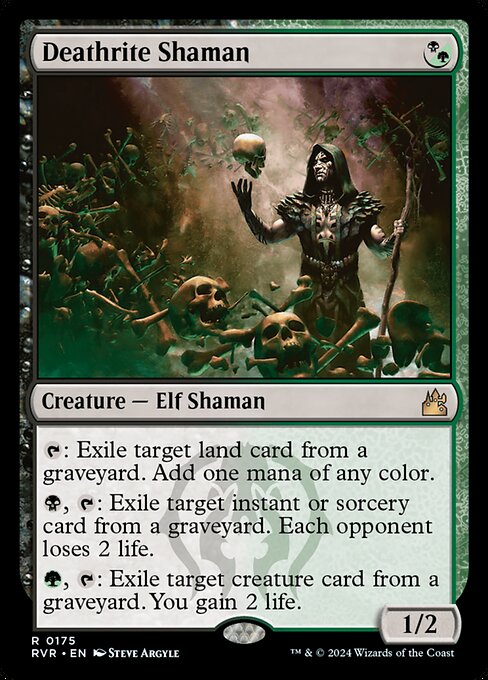
Part Birds of Paradise, part Scavenging Ooze, part Grim Lavamancer, the Shaman was banned in Modern and Legacy but never broke into Standard or Pioneer, although a critical mass of pseudo-fetchlands will eventually push it into playability. Fabled Passage isn’t enough, but we may see it as a pillar of Pioneer at one point. Return to Ravnica was also notable for producing one of the most absurd Limited cards in Pack Rat, but it’s the Shaman that defined Return to Ravnica for me: intriguing on the page, domineering on the table.
2013: Young Pyromancer
Ravnica’s return continued apace, with the Extort-tastic Gatecrash and the letdown that was the final set; Dragon’s Maze featured no actual Dragons and only barely a maze, but it did have Cluestones in pack-clogging abundance. We ended the year with a trip to Theros, but it was the usually-unassuming summer Core Set that had the highlight of the year: Young Pyromancer.

Simple, immediately accessible, and tournament-playable, Young Pyromancer has seen play in every format where it’s legal. I think it’s one of the pinnacles of Magic design. It could have been printed in 1994 or 2024, and an old-school player returning to the game can immediately understand what it does and why it’s desirable. A perfect time capsule card.
2014: Treasure Cruise
The deeply strange Core Set 2015 introduced the new holofoil stamp and border and included cards designed by non-Magic game designers, from Minecraft’s Markus Persson to Binding of Isaac’s Edmund McMillen to Plants Vs. Zombies’ George Fan, all of whom were credited on their (generally conservatively-designed) cards. This expansion outside of Magic, coupled with the copyright-securing and counterfeit-stymying changes to the card face, turned me off the set—before that autumn’s Khans of Tarkir hooked me once again with reprints of the allied fetches and splashy, tricolored clans. While the set was a success, it brought with it Delve, which ran roughshod over tournament Magic.

Treasure Cruise mirrors became races to see who could land an Ancestral Recall first and bury their opponent in an avalanche of cards, and Dig Through Time backed it up. In a format with fetchlands and cheap interaction, which is the foundation of Modern and Legacy, there’s probably no safe Delve, but I’m glad Wizards tested the boundaries with Treasure Cruise. “Draw 3 cards” is the most exciting phrase in Magic, and tacking a Recall effect to a Scornful Egotist mana value presents an interesting puzzle for enfranchised players and a skill test for newer players.
2015: Jace, Vryn’s Prodigy
While older formats dealt with the fallout of Delve, Standard players scrounged up the cash for a different Blue staple: Jace, Vryn’s Prodigy. The smallest Planeswalker flirted with a $90 price tag and was splashed into all kinds of off-Blue decks, facilitated by a format of fetch lands.
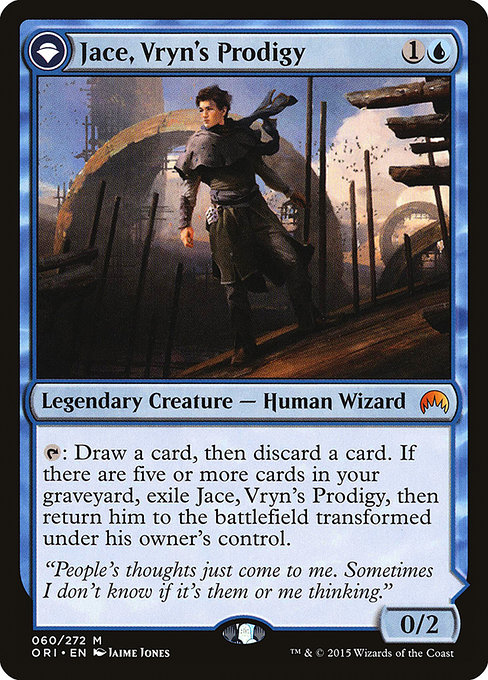
Now, seven years on, he’s been relegated to fringe play—a 0/2 is too easy to deal with, and keeping five cards in your graveyard is a bit of a challenge in a world where everyone has access to Scavenging Ooze, Graveyard Trespasser, or Unlicensed Hearse—but that painful autumn of “Moist Jund” and “Wet Abzan” endures.
2016: Smuggler’s Copter
Wizards has a habit of underestimating the power of new card types, and Vehicles were no different when Kaladesh dropped on September 30th, 2016. Smuggler’s Copter hovered over Standard, Modern, and eventually Pioneer as a threat, card-filtering tool, and ‘Goyf-enabler. In a vacuum, it’s not busted, but then neither was Skullclamp.
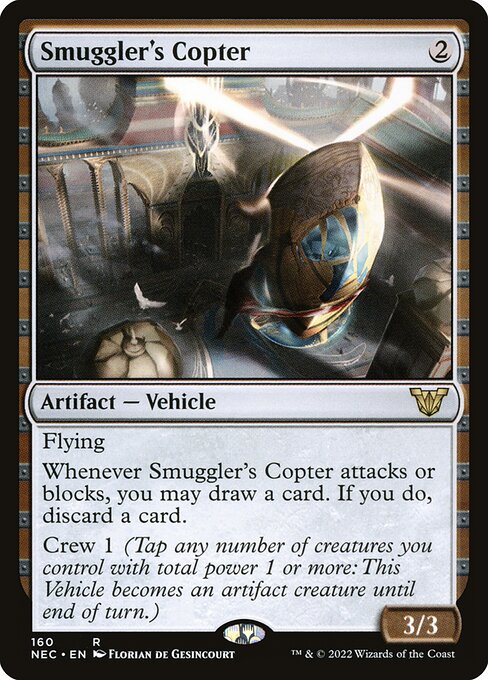
In the context of a game played with creatures where card advantage and selection are game-defining, though, it was absurd, and was banned in Standard in 2017 and in Pioneer in 2019. While I miss seeing it in tournament play, it still keeps Umezawa’s Jitte company in the “colorless two-drop windmill slam” slot in Cubes across the globe. Like Equipment before it, it was a reminder that all the hours of playtesting and scads of design philosophizing can’t quite compete with an army of millions of Magic players determined to break new card types.
2017: Hard Hat Area
I don’t have positive memories of Magic in 2017. Aether Revolt was overshadowed by the day-one errata for Felidar Sovereign and the ban for Smuggler’s Copter and Emrakul, the Promised End, Ixalan was bizarrely underpowered, and the supplementary sets were wearing thin, with Iconic Masters a particularly discouraging fizzle in the Masters line. Amonkhet was a bright spot (ironically), but didn’t make waves outside of a handful of cards, most of which were obvious Commander cards like Anointed Procession, The Scarab God, and our official free preview of Cascading Cataracts.
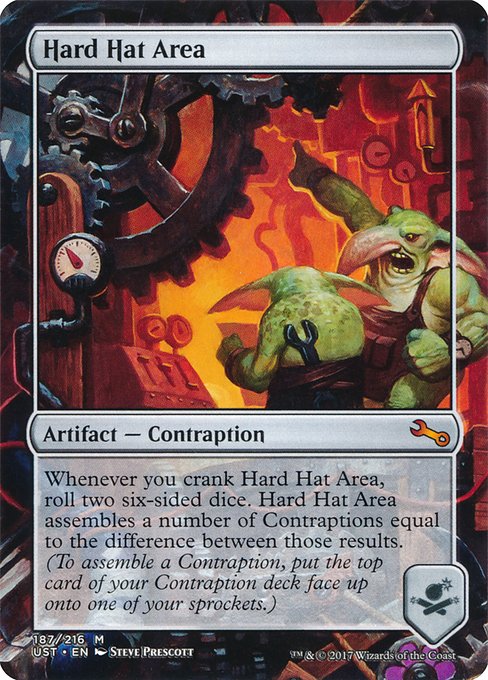
In this one-land mulligan of a year, the highlight came around the holidays with the release of Unstable, an Un- set designed for modern Limited with fewer one-note-joke cards and the debut of Contraptions, long awaited after Future Sight’s teaser. The minigame of Contraptions, which had to be drafted in the mode of Conspiracies, and the inevitable but chaotic nature of how they operated, added some needed tension to a lower-stakes format. Hard Hat Area, for ramping up the chaos of Contraptions, is the only pick here; while we have yet to return to Contraptions, it was a blast in Unstable Draft and could potentially spike when more Contraptions are printed.
2018: Teferi, Hero of Dominaria
After a disappointing 2017, Magic in 2018 played the hits: we went back to Dominaria and to Ravnica for a reset after the gritty and ominous Amonkhet and the vibrant but inert Ixalan. Reprints of checklands and shocklands are always welcome, but the real winner from 2018 was Teferi, Hero of Dominaria.
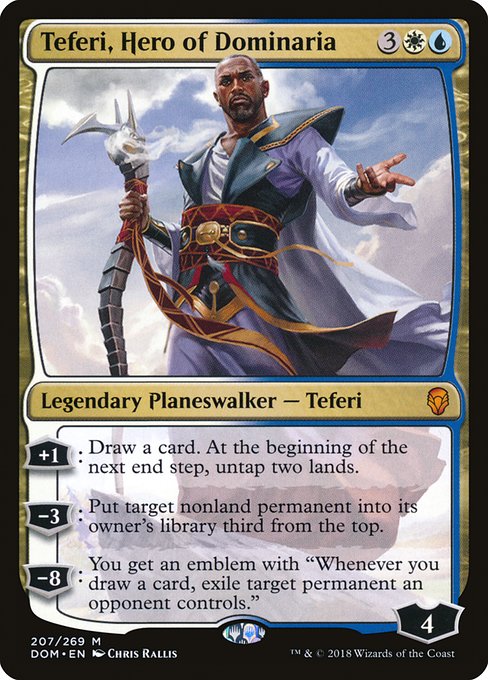
Five-mana planeswalkers can be tough to land, but they do better if you firmly secure them in control colors. During his tenure in Standard, and now in Pioneer, Teferi is a superb control tool, drawing cards and leaving up mana for interaction on your opponent’s turn.
2019: Oko, Thief of Crowns
From one fairly-balanced but powerful Planeswalker to a ban-baiting monstrosity! 2019 was the year of the Planeswalkers, with War of the Spark bringing a whole squad of ‘walkers to the table. Like a lot of folks, I was concerned a broken Planeswalker or two would have made it into the War of the Spark file, but the thirty-six ‘walkers of that set, even Teferi, all paled in comparison to the boogeyman from autumn’s Eldraine: Oko, Thief of Crowns.
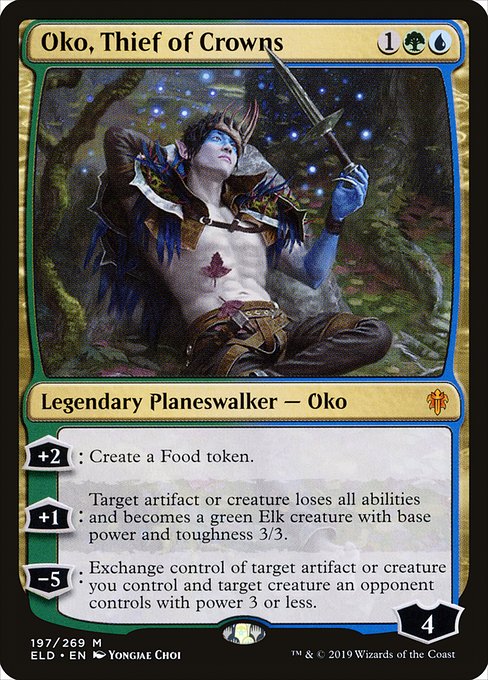
While Karn and Narset ended up restricted in Vintage and Teferi banned from several formats, it was the tantalizing trickster who wound up banned in Standard, Pioneer, Modern, Historic, and Legacy.
2020: Rick, Steadfast Leader
I doubt anyone is in a huge hurry to remember 2020. Revisiting the sets released reminded me of what a nightmare of uncertainty and desperation that year was, from playing Commander masked in someone’s backyard to placing online orders for pickup at stores who would shutter their doors midway through the year, never to reopen. While it’s not a time I care to commemorate much, I do have to point to a watershed moment in Magic history that came in 2020: the printing of cards based on other intellectual properties, in this case Entertainment One’s The Walking Dead.
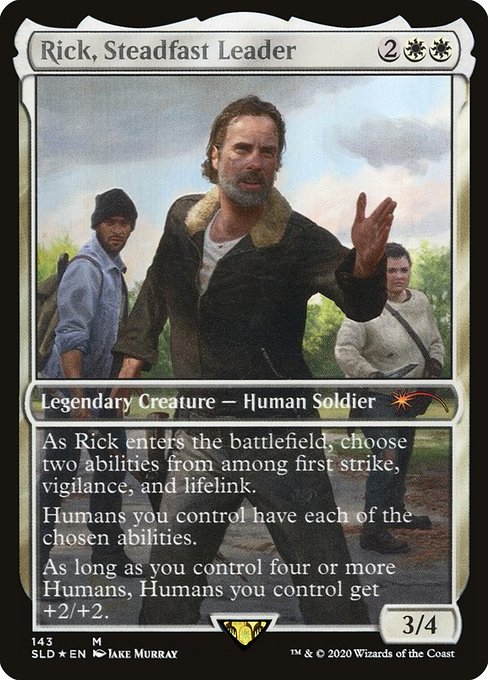
Mechanically unique cards, with art based on real-life actors in a modern American setting, temporarily available through Wizard’s online store, was a shock to the system back then. Wizards has tempered some of the community frustration with some elements of the Universes Beyond product line, including promising to print more on-model versions of cards in mainline Magic sets, but they really ripped the Band-Aid off with that first Secret Lair. Rick, Steadfast Leader is the most memorable card of 2020 to me—pitched as a potential staple for Legacy Humans, which never really came to fruition, he still heralded a new product philosophy for Wizards.
2021: Ragavan, Nimble Pilferer
Magic in 2021 looked to serve different audiences. Arena players got digital-only cards and periodic rebalancing in Alchemy and Historic, collectors got a glut of Secret Lairs, Dungeons and Dragons players got their own standalone set, and those of us with a penchant for Modern got a real monkey’s paw scenario with Modern Horizons 2.
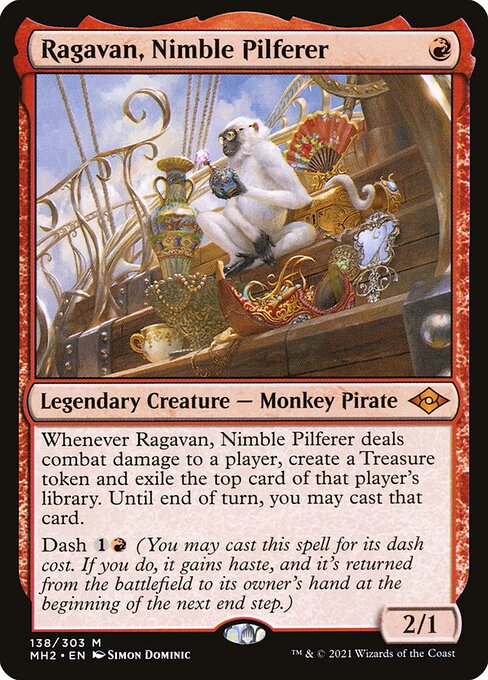
I adore the Modern Horizons sets personally, but they’re certainly disruptive—with the cycle of pitch Elementals, Ragavan, Nimble Pilferer, and new roleplayers like Ignoble Hierarch, Dress Down, and Dauthi Voidwalker, Modern Horizons was an especially environment-altering set. As suitably obnoxious as the little Monkey Pirate is, 2021 will, in some capacity, always be the Year of Ragavan to me.
Ten years is a great vantage point. Pioneer’s card pool is currently at that threshold—or about half the size of Modern’s two-decade span—and we can see how design changes over the course of a decade. Many of Pioneer’s staples have been printed in the last couple of years, as were many of Modern’s new stable of staples, and we can clearly see how they’ve obscured the old pillars of the formats.
I’m humbled by my recent estimation of Sheoldred as “an inferior Kalitas,” but not as humbled as former format boogeyman Tarmogoyf. When Hipsters launched, this fearsome creature was $90 a copy and a rock-solid four-of in deck after deck; now, you can get a playset for less than that. No telling where we’ll be in ten more years, although I wouldn’t be surprised if I’m reminiscing about buying a single Ragavan for the cost of a playset in 2032, but I can all but guarantee it’ll involve whatever Magic: The Gathering and Hipsters of the Coast become.
A lifelong resident of the Carolinas and a graduate of the University of North Carolina, Rob has played Magic since he picked a Darkling Stalker up off the soccer field at summer camp. He works for nonprofits as an educational strategies developer and, in his off-hours, enjoys writing fiction, playing games, and exploring new beers.

